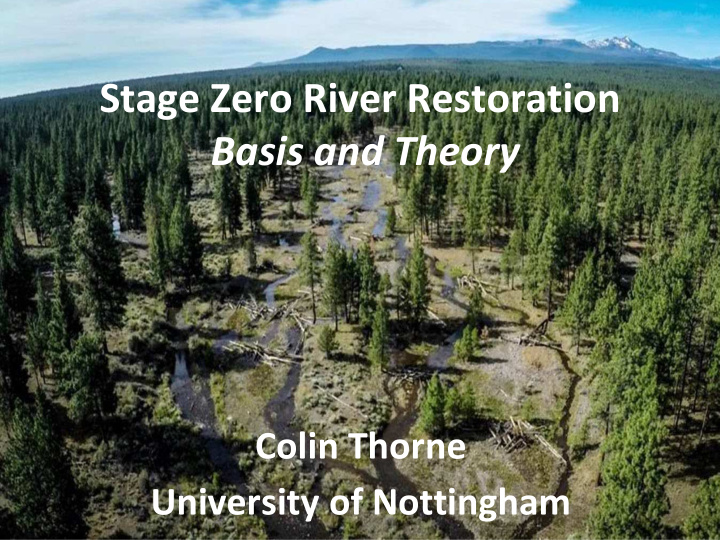



Stage Zero River Restoration Basis and Theory Colin Thorne University of Nottingham
OVERVIEW Basis: The Stream Evolution Model Anabranching Rivers in Nature Theory: Bankfull Flow in Transport and Response reaches Valley Confinement: ‘Strings of Beads’ & Ribbons Single-thread, stable channels: not the only choice?
Basis: THE STREAM EVOLUTION MODEL ANABRANCHING CHANNELS IN NATURE
Channel Evolution 1984 Models… INCISED CHANNELS Morphology, Dynamics, and Control Schumm, Harvey & Watson Water Resources Publications, Littleton, Colorado
Floodplain Disconnection: Crowder Creek, North Mississippi: late-1970s
Response to Channel – Floodplain Disconnection Connected floodplain system: Disconnected floodplain system:
Stanley Schumm, Mike Harvey and Chester Watson 1984 Schumm, S. A., Harvey, M. D., & Watson, C. C. (1984). Incised channels: morphology, dynamics, and control . Water Resources Publications.
2008 “…before European settlement, the Historical evidence - US East Coast – streams were small, anabranching Watts Branch, Seneca Creek, Brandywine Creek etc. channels within extensive, vegetated wetlands” Walter, R.C. and Merritts, D.J., 2008. Natural streams and the legacy of water-powered mills. Science , 319 (5861), pp.299-304.
River Planforms over Geological Time Fluvial Style Plant Evolution Mya Permian Log jams 300 “…expansion of tree habitats led to the Anastomosed and Island-braided Gymnosperms Carboniferous crossing of a threshold in vegetative 350 Seed plants Trunk meandering control of floodplain and river Devonian Early Forests 400 Definitive roots Small meandering morphology.” Root-like Silurian Channel-braided forms 450 Ordovician Davies, N.S. and Gibling, M.R., 2011. Nature Geoscience , 4 (9), pp.629-633 500 Sheet-braided Cambrian 550 Until global vegetation, most rivers BRAIDED. After plants appeared rivers started MEANDERING and become ANASTOMOSED after modern trees evolved. Slide compiled by Dr Matt Johnson, Nottingham U.
Mical Tal: Interactions between vegetation and braiding leading to a single-thread channel Dissertation submitted to the faculty of the graduate school of the University of Minnesota
“Fight the enemy where he isn’t” General Sun Tzu - ‘The Art of War’ (512 BC) Mical Tal: Interactions between vegetation and braiding leading to a single-thread channel
Published January 10, 2013.
Channelization of Stage 0 streams Cluer and Thorne, RRA, 2013
Theory: BANKFULL FLOW IN TRANSPORT AND RESPONSE REACHES VALLEY CONFINEMENT STABLE CHANNEL DESIGN
Bankfull stage and discharge - key restoration design factors Natural Natural levee levee
Bankfull Discharge = Return period ~1.5 Flow doing most years Sediment Transport Adapted from Wolman and Miller (1960)
Source Transport Response
Transport Reach – Qs in = Qs out
Depositional Reach – Qs in > Qs out
Theory: BANKFULL FLOW IN TRANSPORT AND RESPONSE REACHES VALLEY CONFINEMENT STABLE CHANNEL DESIGN
“ valley confinement - a primary control on many fluvial geomorphic processes that occur on (and along) valley bottoms….. downstream sequence of valley settings - a key control on longitudinal patterns of hydrology and sediment flux, as well as dictating the pattern of river types” Fryirs et al. (2016)
Valley Confinement and Confining Features
Beads on a string Mark Beardsley Riparian
Floodplains as Ribbons
Theory: BANKFULL FLOW IN TRANSPORT AND RESPONSE REACHES VALLEY CONFINEMENT STABLE CHANNELS
Source Transport Response
Resistant Banks Erodible Banks Dynamically Dynamically Stable, Mobile Bed Stable, Multi-thread Bedload Single-thread planforms planforms Braided Straight Mixed Load Island Braided Meandering Suspended Load Stable Bed Anastomosed Sediment Rich Sediment Poor Channel patterns after Schumm 1985, modified from Knighton, 1998.
Copeland Stable Channel Design Method: for a given Width: Flow resistance: Q = f (Depth, Slope) Sediment transport: Q s = f (Depth, Erosion Slope) Stable Slope width Sedimentation Width US Army Corps of Engineers: SAM = Stable Analytical Method
Source Transport Response
Resistant Banks Erodible Banks Dynamically Dynamically Stable, Mobile Bed Stable, Multi-thread Bedload Single-thread planforms planforms Braided Straight Mixed Load Island Braided Meandering Suspended Load Stable Bed Anastomosed Sediment Rich Sediment Poor Channel patterns after Schumm 1985, modified from Knighton, 1998.
Biology The Stream Evolution Triangle Geology Hydrology SET with the planform patterns defined by Schumm (1985). Castro and Thorne (2019). Castro, J.M. and Thorne, C.R. 2019. The Stream Evolution Triangle: linking Geology, Hydrology and Biology, River Research and Applications . https://doi.org/10.1002/rra.3421
Colorado River, USA
Rakaia River, NZ
Rio Negro, BR
Why don’t we see many anastomosed rivers? Anastomosed Anabranched Meandering 1828 – Prior to 1872 – after re-alignment 1963 – fully canalised river training by Johann Gottfried Tulla single-thread River Rhine, Germany
Parana Japura Brahmaputra Orinoco
Post-2000 research challenges single-thread, meandering as a natural, ubiquitous pre-disturbance condition: Europe - Tony Brown, John Lewin, Nicola Surian Eastern US - Robert Walter and Dorothy Merrits California – Robin Grossinger and others Pacific Northwest - Dave Montgomery and Brian Collins Photograph by Brian Cluer ,
Further Reading Walter, R.C. and Merritts, D.J., 2008. Natural streams and the legacy of water- powered mills. Science, 319(5861), pp.299-304. Cluer, B. and Thorne, C., 2014. A stream evolution model integrating habitat and ecosystem benefits. River Research and Applications , 30(2), pp.135-154. Pollock, M., Beechie, T., Wheaton, J., Jordan, C., Bouwes, N., Weber, N. & Volk, C. 2014. Using Beaver Dams to Restore Incised Stream Ecosystems. BioScience . xx. 1-12. DoI. 10.1093/biosci/biu036. Davies, N.S. and Gibling, M.R., 2011. Nature Geoscience, 4(9), pp.629-633 Schumm, S.A., 1977. The fluvial system . New York: Wiley. Wolman, M.G. and Miller, J.P., 1960. Magnitude and frequency of forces in geomorphic processes. The Journal of Geology , 68(1), pp.54-74. Hey, R.D., 1979. Dynamic process-response model of river channel development. Earth Surface Processes, 4(1), pp.59-72. Fryirs, K.A., Wheaton, J.M. and Brierley, G.J., 2016. An approach for measuring confinement and assessing the influence of valley setting on river forms and processes. Earth Surface Processes and Landforms , 41(5), pp.701-710. Thomas, A., Copeland, R. and McComas, D. 2002. SAM (Stable Alluvial Method) Design Package for Channels, USACE-CHL, ERDC, Vicksburg. https://www.fs.fed.us/biology/nsaec/fishxing/fplibrary/ACOE_2002_SAM_Hydr aulic_Design_Package_for_Channels.pdf
Recommend
More recommend